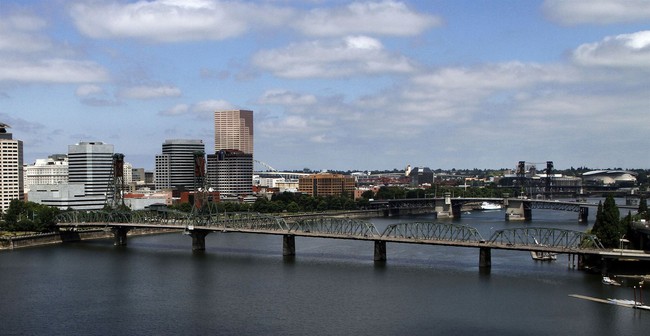
In February, Portland’s City Administrator announced that the city would need to slash jobs and maintenance projects in order to address a $93 million shortfall in the annual budget.
“There aren’t really any good choices here,” said City Administrator Michael Jordan at a press briefing. “It’s about where you will find the money to balance the budget.”…
To balance the general fund gap, Jordan suggests cutting $22 million from the transportation bureau’s street maintenance and repair programs, slashing $19 million in parks services by reducing community center hours and eliminating summer programs, and eliminating nearly 300 jobs across all city bureaus.
A $93 million shortfall isn’t nothing, but in the scope of Portland’s $8.2 billion annual budget it’s still a fairly small percentage. But it turns out that shortfall is only a fraction of the real problem the city is facing. The city has underinvested in maintenance of its aging infrastructure for years. Portland is literally falling apart.
Broken crosswalk lights. Tennis courts split open with uneven asphalt. Playground slides covered in rust. A fire station roof leaking water. Broken sewage pipes. A public restroom with a rodent infestation.
Years of neglect has left Portland roads, buildings, parks facilities, water systems, technology and other types of infrastructure deteriorating at an unsafe — and expensive — pace. The city owns nearly $75 billion in these types of structures and equipment, and much of it was built over 50 years ago. According to a city audit released Wednesday, most of the city’s infrastructure is “near or beyond the end of its useful life.” And it would cost the city more than $1 billion per year to make needed repairs.
“For years, the city has underinvested in routine and preventative maintenance of its aging assets,” reads the audit, led by City Auditor Simone Rede. “This underinvestment has created a backlog of costly and increasingly urgent needs that the city does not have the funding to meet.”
It won’t fail all at once of course, but in another 15 years, 20% of the city’s assets may no longer be useable. Based on the $75 billion in assets mentioned above, that could be billion of dollars to repair or replace, more than the city’s entire annual budget. Or, more likely, city assets will just close to residents.
If the City does not start catching up on its backlog, auditors warn the city will face disrupted or discontinued services, that could lead to “more serious safety, livability, and economic challenges.”
“For example, in recent years, several Portland Parks & Recreation assets, including pools, picnic shelters, light poles, trail bridges, and playground equipment, have failed and had to be closed or removed to protect the public. Parks predicts that without new, stable funding, 20% of its assets could fail in the next fifteen years,” the audit says.
An anonymous city employee quoted in the audit explained, “We are great at buying shiny new things… But we are not good at maintaining, operating, and renovating the assets we already have. So, then the assets end up making the decisions for us when they fail and we must decide to replace them or not. It becomes a game of whack-a-mole.”
The longer the city waits to address the problem, the larger the bill will become on an annual basis.
According to city data, repairing aging infrastructure was estimated to cost the city about $300 million a decade ago. Left unaddressed, that bill rose to $500 million by 2019. And the latest estimate from 2023 puts the cost at $1.4 billion.
But because the city is also having budget problems, even the city auditor who prepared the report admits addressing the problem looks “impossible.”
“Given the city’s estimated $93 million budget shortfall, it seems impossible to find more funding for maintaining the public’s assets,” [City Auditor Simone] Rede said. “But, without a strategy for closing Portland’s infrastructure funding gap, it will continue to grow, and to put more assets at risk of failure, resulting in less services to Portlanders.”
Usually when I’m writing about a “doom loop” scenario I’m talking about San Francisco, but some of the same logic seems to be relevant in this case. If Portland can’t afford to make repairs, city services will fail and the city itself will become a less appealing place to live, potentially impacting property values and future budgets and creating a downward spiral that only makes future maintenance of the same assets harder for the city to afford.
The city administrator has agreed to put in place a citywide asset management strategy but he says that can’t be ready until Sep. 2027, nearly 2 1/2 years from now. The strategy might bring some needed order to the maintenance of city assets but it won’t magically make the $1.4 billion per year needed to fund those repairs manifest itself. At some point the city is going to have to make some tough choices.






